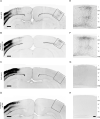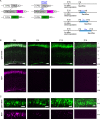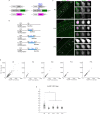Developmental stage-specific spontaneous activity contributes to callosal axon projections
- PMID: 36001081
- PMCID: PMC9402231
- DOI: 10.7554/eLife.72435
Developmental stage-specific spontaneous activity contributes to callosal axon projections
Abstract
The developing neocortex exhibits spontaneous network activity with various synchrony levels, which has been implicated in the formation of cortical circuits. We previously reported that the development of callosal axon projections, one of the major long-range axonal projections in the brain, is activity dependent. However, what sort of activity and when activity is indispensable are not known. Here, using a genetic method to manipulate network activity in a stage-specific manner, we demonstrated that network activity contributes to callosal axon projections in the mouse visual cortex during a 'critical period': restoring neuronal activity during that period resumed the projections, whereas restoration after the period failed. Furthermore, in vivo Ca2+ imaging revealed that the projections could be established even without fully restoring highly synchronous activity. Overall, our findings suggest that spontaneous network activity is selectively required during a critical developmental time window for the formation of long-range axonal projections in the cortex.
Keywords: activity dependent; cerebral cortex; development; mouse; neuroscience.
© 2022, Tezuka, Hagihara et al.
Conflict of interest statement
YT, KH, KO, TH, YT No competing interests declared
Figures








Similar articles
-
Pre-synaptic and post-synaptic neuronal activity supports the axon development of callosal projection neurons during different post-natal periods in the mouse cerebral cortex.Eur J Neurosci. 2010 Feb;31(3):410-24. doi: 10.1111/j.1460-9568.2009.07070.x. Epub 2010 Jan 25. Eur J Neurosci. 2010. PMID: 20105242
-
Activity-dependent callosal axon projections in neonatal mouse cerebral cortex.Neural Plast. 2012;2012:797295. doi: 10.1155/2012/797295. Epub 2012 Nov 19. Neural Plast. 2012. PMID: 23213574 Free PMC article. Review.
-
Transitory corpus callosum axons projecting throughout developing rat visual cortex revealed by Dil.Cereb Cortex. 1994 May-Jun;4(3):279-99. doi: 10.1093/cercor/4.3.279. Cereb Cortex. 1994. PMID: 8075533
-
Distribution of transitory corpus callosum axons projecting to developing cat visual cortex revealed by DiI.J Comp Neurol. 1993 Jul 15;333(3):326-42. doi: 10.1002/cne.903330303. J Comp Neurol. 1993. PMID: 8349847
-
Activity-dependent development of interhemispheric connections in the visual cortex.Rev Neurosci. 2008;19(1):19-28. doi: 10.1515/revneuro.2008.19.1.19. Rev Neurosci. 2008. PMID: 18561818 Review.
Cited by
-
Host brain environmental influences on transplanted medial ganglionic eminence progenitors.Sci Rep. 2024 Feb 13;14(1):3610. doi: 10.1038/s41598-024-52478-6. Sci Rep. 2024. PMID: 38351191 Free PMC article.
-
Mef2c Controls Postnatal Callosal Axon Targeting by Regulating Sensitivity to Ephrin Repulsion.bioRxiv [Preprint]. 2025 Jan 22:2025.01.22.634300. doi: 10.1101/2025.01.22.634300. bioRxiv. 2025. Update in: J Neurosci. 2025 May 21;45(21):e0201252025. doi: 10.1523/JNEUROSCI.0201-25.2025. PMID: 39896513 Free PMC article. Updated. Preprint.
-
Epigenetic and Transcriptional Regulation of Spontaneous and Sensory Activity Dependent Programs During Neuronal Circuit Development.Front Neural Circuits. 2022 May 18;16:911023. doi: 10.3389/fncir.2022.911023. eCollection 2022. Front Neural Circuits. 2022. PMID: 35664458 Free PMC article. Review.
-
Correlated Somatosensory Input in Parvalbumin/Pyramidal Cells in Mouse Motor Cortex.eNeuro. 2023 May 8;10(5):ENEURO.0488-22.2023. doi: 10.1523/ENEURO.0488-22.2023. Print 2023 May. eNeuro. 2023. PMID: 37094939 Free PMC article.
-
Diverse axonal morphologies of individual callosal projection neurons reveal new insights into brain connectivity.Curr Opin Neurobiol. 2024 Feb;84:102837. doi: 10.1016/j.conb.2023.102837. Epub 2024 Jan 24. Curr Opin Neurobiol. 2024. PMID: 38271848 Free PMC article. Review.
References
-
- Alexander GM, Rogan SC, Abbas AI, Armbruster BN, Pei Y, Allen JA, Nonneman RJ, Hartmann J, Moy SS, Nicolelis MA, McNamara JO, Roth BL. Remote control of neuronal activity in transgenic mice expressing evolved G protein-coupled receptors. Neuron. 2009;63:27–39. doi: 10.1016/j.neuron.2009.06.014. - DOI - PMC - PubMed
Publication types
MeSH terms
Associated data
LinkOut - more resources
Full Text Sources
Miscellaneous

